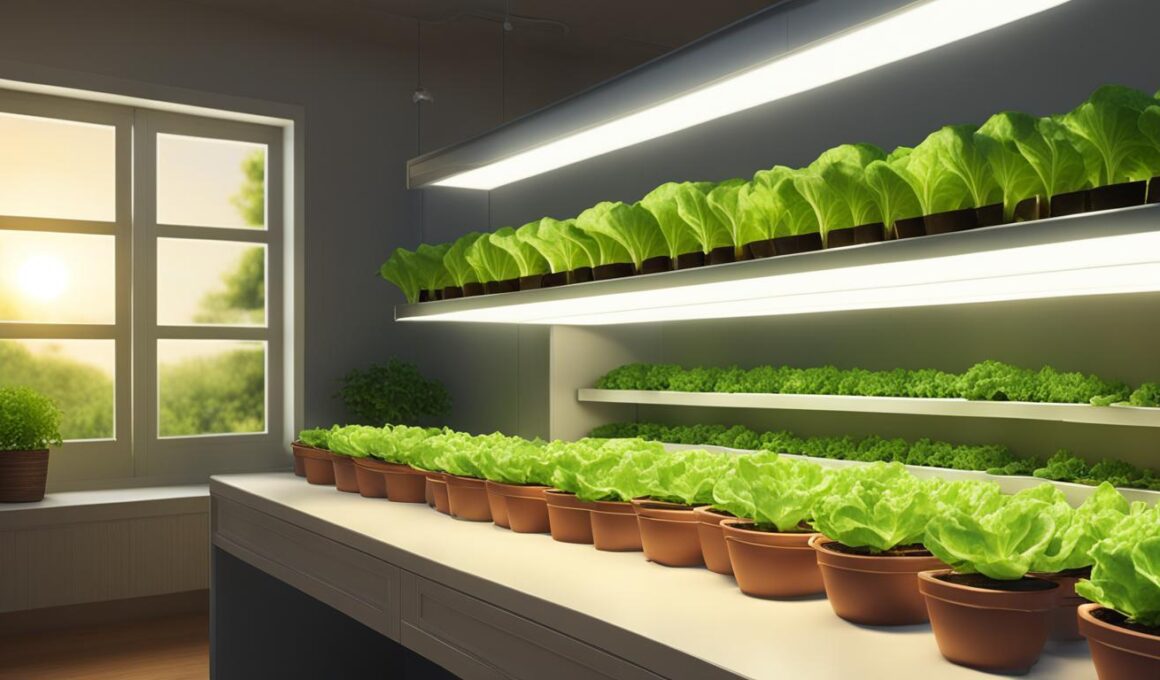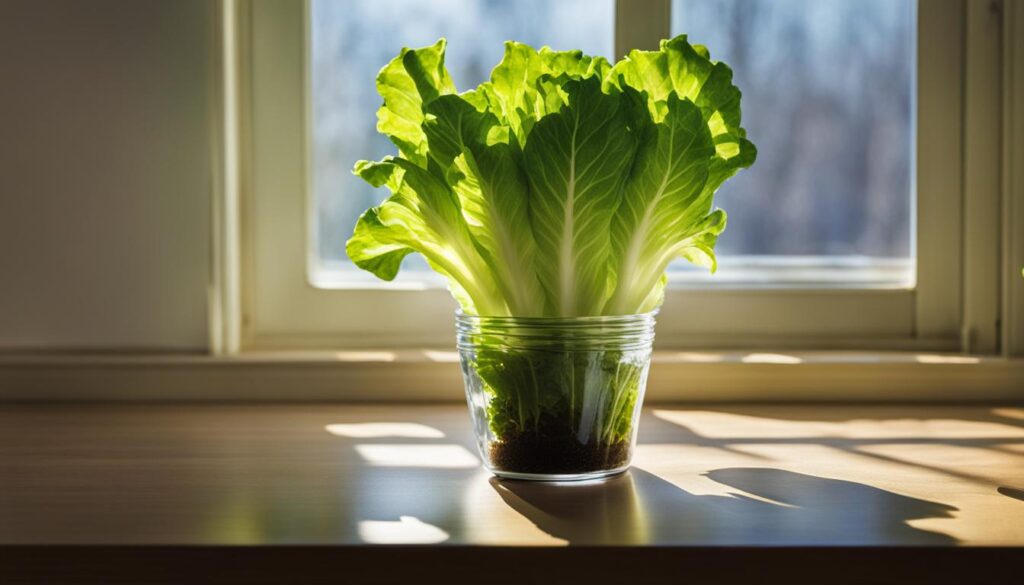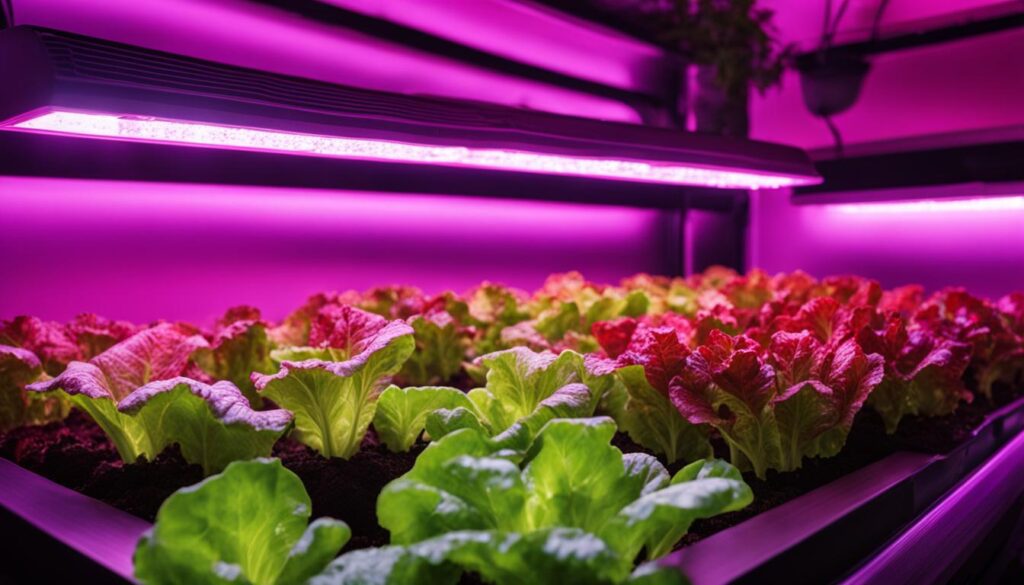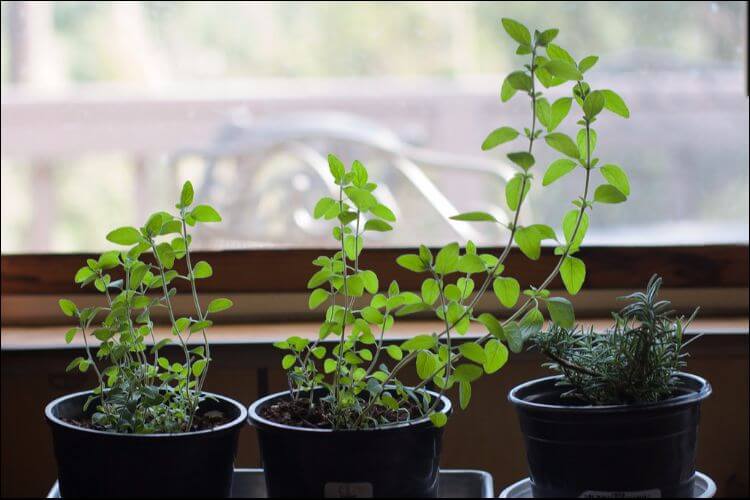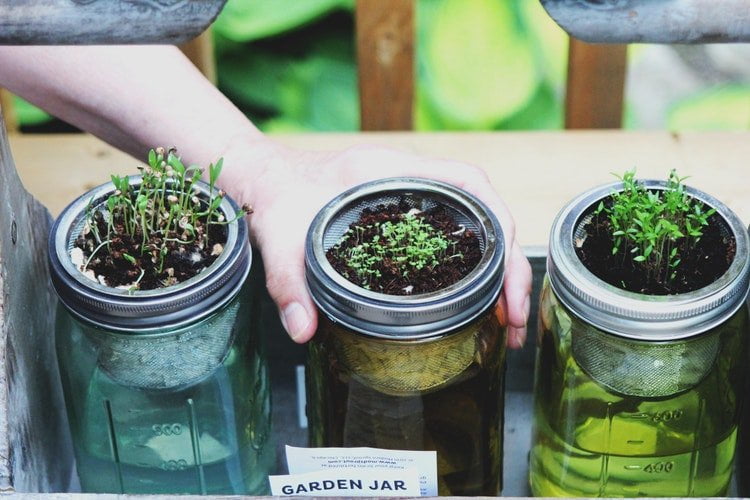Growing lettuce indoors allows for fresh greens year-round. To successfully grow lettuce indoors, it is essential to provide the right amount of light. Full sun or a south-facing window with at least 12 hours of sunlight is ideal, but most indoor spaces do not have sufficient natural light. Therefore, using a grow light is necessary to ensure lettuce thrives indoors. Tabletop grow light systems or larger light gardens can be used depending on the space available. It is important to place the grow light away from heat sources, drafts, and pets.
Post Summary
- Indoor lettuce requires the right amount of light for optimal growth.
- Full sun or a south-facing window with at least 12 hours of sunlight is ideal but may not be available in most indoor spaces.
- Using a grow light system is necessary to ensure lettuce thrives indoors.
- Tabletop grow lights or larger light gardens can be used depending on the available space.
- Placement of the grow light away from heat sources, drafts, and pets is important for successful indoor lettuce cultivation.
Choosing the Right Container, Medium, and Seeds
When it comes to growing lettuce indoors, selecting the appropriate container, growing medium, and seeds is crucial for successful cultivation. Here are some factors to consider:
Container:
Opt for a flat and shallow container with good drainage to prevent excess water accumulation. Plastic pots or multi-cell seed-starting systems are also suitable options.
Growing Medium:
Choose a planting mix specifically designed for seed starting, as garden soil or potting soil may not provide the necessary nutrients and drainage. Using a suitable growing medium promotes healthy root development and overall plant growth.
Table [insert table here with container options and their features]
Seeds:
Select lettuce varieties that are well-suited for indoor growing. Loose-leaf varieties such as Baby Oakleaf, Tom Thumb, and Black-Seeded Simpson are popular choices. These varieties adapt well to limited space and can be harvested at different stages of maturity.
Table [insert table here with lettuce varieties and their characteristics]
By carefully considering the container, medium, and seeds for your indoor lettuce garden, you can create an ideal environment for successful cultivation.
Note: The images used in this article are for illustrative purposes only.
Planting and Germination
Once you have selected the right container and growing medium for your indoor lettuce cultivation, it’s time to plant the seeds and begin the germination process. Follow these steps to ensure successful planting and germination:
- Moisten the soil: Before filling the containers with the planting mix, make sure to moisten the soil. This will provide a suitable environment for the seeds to germinate.
- Fill the containers: Fill the chosen containers with the planting mix, leaving about an inch of space at the top to prevent overflow when watering.
- Scatter or plant the seeds: Scatter the lettuce seeds evenly on top of the planting mix or plant them in rows, according to your preference. Ensure that the seeds are spaced apart, allowing enough room for growth.
- Cover the seeds: Gently cover the seeds with a thin layer of the planting mix, creating a protective barrier. This will help retain moisture and promote germination.
- Choose a warm location: Place the containers in a warm location, such as near a sunny window or on a heating mat. The optimum temperature for lettuce seed germination is between 65-75°F (18-24°C).
During the germination process, it’s essential to keep the seedlings moist but not overwatered. Overwatering can lead to fungal diseases, while underwatering can hinder germination. Once the sprouts appear, remove the cover and thin the seedlings, spacing them about an inch apart. This allows each seedling to receive ample resources for growth.
Monitor the growth of the seedlings closely and make necessary adjustments to maintain optimal moisture levels. Remember to water the seedlings from the bottom to prevent waterlogging the soil. With proper care and attention, your lettuce seeds will germinate and begin their journey towards healthy growth.
Germination Timeline for Lettuce Seeds
| Days after Planting | Germination Stage |
|---|---|
| 7-10 days | Seeds Begin to Sprout |
| 14-21 days | Establishment of Seedlings with First True Leaves |
| 21-28 days | Seedlings Display Significant Growth |
Note: The germination timeline may vary depending on the lettuce variety and environmental conditions.
Providing Proper Growth Conditions
Creating the optimal growth conditions for your indoor lettuce is crucial for its success. It starts with ensuring that your seedlings are receiving adequate light. Green and robust seedlings indicate that they are getting enough light, while leggy or yellowed plants are signs of insufficient light. To meet their light requirements, you can use grow lights specifically designed for indoor gardening. LED lights, such as VIPARSPECTRAL, Famurs, and AntLux, are recommended for their energy efficiency and light quality.
Aside from light, proper moisture levels are essential for the growth of indoor lettuce. Overwatering or underwatering can lead to various issues, including root rot or stunted growth. One way to maintain proper moisture levels is by using a seed-starting system with a wicking mat and water reservoir. This setup ensures consistent moisture for your lettuce seedlings. Regular monitoring of the moisture level and adjusting as necessary will help keep your plants healthy.
Once your seedlings have developed their first set of true leaves, you can start feeding them with a mild diluted fertilizer. This provides them with the necessary nutrients for healthy growth. It is important to follow the recommended dosage and not overfertilize, as it can harm the plants. Careful observation and adjustment of the moisture and nutrient levels will contribute to the optimal growth of your indoor lettuce.
In summary, providing proper growth conditions for your indoor lettuce involves ensuring adequate light, monitoring moisture levels, and providing appropriate nutrients. By creating an environment that mimics outdoor conditions, you can enjoy fresh and healthy lettuce year-round.
Harvesting Indoor Lettuce
Harvesting indoor lettuce is an exciting and rewarding part of the growing process. After approximately three to four weeks of growth, when the lettuce plants reach a height of about 4 inches, they are ready to be harvested. To ensure a continuous supply of fresh lettuce, it is advisable to cut only what is needed, starting with the outer leaves and leaving the inner leaves to continue growing.
By harvesting selectively, you can enjoy fresh lettuce leaves for a longer period. It is important to handle the lettuce gently while harvesting to prevent damage. The freshness and taste of the harvested leaves can be enhanced by placing them in a bowl of cold water for a few minutes before use. Remember to pat them dry before adding them to your favorite salad or sandwich.
To maintain a continuous growing cycle, new seeds can be planted immediately after harvesting. This ensures a steady supply of fresh lettuce throughout the year. It is worth noting that certain lettuce varieties, like Spinach, Green Oakleaf, and Arugulas, should be fully harvested earlier to prevent them from bolting. Bolting occurs when the lettuce plant begins to produce flowers and seeds, leading to a decline in leaf quality and taste.
Assessing Natural Light Conditions
When growing lettuce indoors, it’s crucial to assess the availability and consistency of natural light in your indoor space. Leafy greens, including lettuce, require at least 5 hours of direct sunlight per day. South-facing windows usually provide the brightest natural light. However, the intensity and duration of sunlight vary with the seasons.
To determine if natural light is sufficient for optimal lettuce growth, you need to evaluate the natural light environment in your indoor space. Observe the amount of direct sunlight the area receives throughout the day and track any variations in light intensity and duration.
Evaluating Natural Light Conditions
To assess natural light conditions, follow these steps:
- Choose a typical day and record the number of hours of direct sunlight your indoor space receives. Measure the duration of sunlight throughout the day to determine the peak hours of light exposure.
- Consider any obstacles that could block or reduce sunlight, such as nearby buildings or large trees. These obstructions can cast shadows and limit the amount of light reaching your lettuce plants.
- Monitor the consistency of sunlight throughout the year. Note any seasonal changes that could affect the availability of natural light for your indoor lettuce garden.
By evaluating natural light conditions, you can determine if supplemental grow lights are necessary to meet the light requirements of your lettuce plants. Adequate light is essential for photosynthesis, plant growth, and the development of healthy and flavorful lettuce leaves.
| Light Conditions | Sunlight Availability |
|---|---|
| Full Sun | Direct sunlight for 6-8 hours or more per day |
| Partial Sun | Direct sunlight for 4-6 hours per day |
| Partial Shade | Direct sunlight for 2-4 hours per day |
| Shade | Direct sunlight for less than 2 hours per day |
Table: Sunlight Availability for Indoor Lettuce
Choosing the Right Grow Lights
When it comes to indoor lettuce cultivation, choosing the right grow lights is essential for providing the necessary light for optimal growth. Different types of grow lights are available, including LED and fluorescent lights, each with their own advantages and considerations.
LED Lights: LED lights offer several benefits for lettuce cultivation. They are energy-efficient, producing less heat compared to other types of lights. LED lights also have a longer lifespan, reducing the need for frequent replacements. Additionally, LED lights provide a wide range of light quality options, allowing for customizable lighting conditions for lettuce plants.
Fluorescent Lights: Fluorescent lights are another popular choice for indoor lettuce cultivation. They provide a well-balanced light spectrum that promotes healthy growth. Fluorescent lights are also more affordable compared to LED lights, making them a cost-effective option for growers.
When selecting grow lights, factors such as wattage, lifespan, and light quality should be considered. It is also important to ensure that the chosen lights are suitable for lettuce cultivation and provide the necessary intensity for optimal growth. Some recommended LED grow lights for lettuce include VIPARSPECTRAL, Famurs, and AntLux. The AntLux 50W 4Ft Growing Lamp is a popular fluorescent light option for lettuce and other leafy greens.
GROW LIGHT COMPARISON
| Grow Light | Light Type | Wattage | Lifespan | Light Quality |
|---|---|---|---|---|
| VIPARSPECTRAL | LED | 300W | 100,000 hours | Full spectrum |
| Famurs | LED | 600W | 50,000 hours | Red and blue spectrum |
| AntLux 50W 4Ft Growing Lamp | Fluorescent | 50W | 30,000 hours | Full spectrum |
Comparing different grow lights based on their wattage, lifespan, and light output can help determine the most suitable option for indoor lettuce growing. It is important to choose grow lights that provide the necessary light intensity and quality for lettuce cultivation, ensuring healthy and productive plants.
Setting Up a Grow Light System
Setting up a grow light system is an essential step in ensuring the successful cultivation of indoor lettuce. By providing the right amount and quality of light, you can create an optimal growing environment for your plants. Here are some important considerations when setting up your grow light system:
Choosing the Right Grow Lights
When selecting grow lights for your indoor lettuce garden, consider using LED or fluorescent lights. LED lights are energy-efficient and offer a wide range of light quality, while fluorescent lights are suitable for lettuce and other leafy greens. Take into account factors such as wattage, lifespan, and light quality when choosing the right grow lights for your needs.
Positioning the Grow Lights
Proper positioning of the grow lights is crucial for the healthy growth of your lettuce plants. Place the lights above the plants at a distance of approximately 6 inches. It is important to follow the manufacturer’s instructions for the specific grow lights you are using to ensure the best results.
Matching the Light Cycle
To optimize lettuce growth, it is important to match the light cycle of your grow lights with the natural photoperiod. This means providing the right amount of light and darkness at appropriate intervals. By understanding the natural light conditions and adjusting your grow light system accordingly, you can create an environment that mimics outdoor growing conditions and promotes healthy lettuce growth.
Remember to regularly monitor the growth of your lettuce plants and make any necessary adjustments to the position or intensity of the grow lights. By setting up a well-designed grow light system, you can provide your indoor lettuce garden with the light it needs to thrive.
Grow Light Recommendations for Lettuce
When it comes to indoor lettuce cultivation, selecting the right grow lights is crucial for ensuring optimal growth. Here are some highly recommended grow lights that have proven to be effective for lettuce cultivation:
“VIPARSPECTRAL LED Grow Light: This grow light offers a range of wattages and lifespans to suit different needs. With its high-quality LED technology, it provides the perfect light spectrum for lettuce cultivation.”
“Famurs LED Grow Light: Known for its energy efficiency and long lifespan, this grow light is ideal for indoor lettuce cultivation. It provides a balanced light spectrum that promotes healthy growth and robust foliage.”
“BestVA LED Grow Light: With its high wattage and impressive light output, this grow light ensures that lettuce plants receive the necessary light intensity for optimal growth. It is a popular choice among indoor gardeners.”
For growers who prefer fluorescent lights, the AntLux 50W 4Ft Growing Lamp is an excellent option. It provides sufficient light for lettuce cultivation while being energy-efficient and affordable.
When choosing the right grow light, consider factors such as budget, space availability, and desired light intensity. It’s also important to compare different grow lights based on their wattage, lifespan, and light output to determine the most suitable option for your indoor lettuce growing needs.
| Grow Light | Features |
|---|---|
| VIPARSPECTRAL LED Grow Light | Range of wattages and lifespans |
| Famurs LED Grow Light | Energy-efficient and long lifespan |
| BestVA LED Grow Light | High wattage and impressive light output |
| AntLux 50W 4Ft Growing Lamp | Energy-efficient and affordable fluorescent light |
With the right grow lights, you can provide your indoor lettuce plants with the optimal light conditions they need to thrive and produce fresh greens for your enjoyment.
Creating an Optimal Indoor Growing Environment
When it comes to growing lettuce indoors, creating an optimal growing environment is essential to ensure the success of your indoor garden. By providing the right conditions for your lettuce plants, you can maintain their growth and health throughout their lifecycle. Here are some key factors to consider:
Lighting
One of the most important aspects of indoor lettuce cultivation is providing adequate lighting. Lettuce requires at least 12 hours of light per day to grow optimally. If natural light is not sufficient, you can use grow lights to supplement the lighting needs of your plants. LED grow lights are a popular choice for indoor gardening as they are energy-efficient and provide the right spectrum of light for plant growth.
Moisture and Humidity
Lettuce thrives in a moist environment, so it’s crucial to maintain the right moisture levels for your plants. Water your lettuce regularly, ensuring that the soil is evenly moist but not waterlogged. Monitor the humidity levels in your indoor space and use a humidifier if necessary to create the ideal conditions for your lettuce plants.
Air Circulation
Proper air circulation is important for lettuce plants as it helps prevent the buildup of humidity and reduces the risk of diseases. Ensure that there is adequate airflow around your plants by using fans or opening windows. Be careful not to place your lettuce plants near drafts or heat sources, as this can negatively impact their growth.
By paying attention to these factors and making necessary adjustments, you can create an optimal indoor growing environment for your lettuce. Regular maintenance, such as pruning, checking for pests, and resetting the growing system when needed, will help ensure the long-term health and productivity of your indoor lettuce garden.
| Factors to Consider for an Optimal Indoor Growing Environment |
|---|
| Lighting |
| Moisture and Humidity |
| Air Circulation |
Tips for Using Glow Rings and Farmstands
For optimal growth of your indoor lettuce, using Glow Rings in conjunction with Farmstands can provide an efficient and effective lighting solution. Glow Rings are high-efficiency LED lights specially designed to integrate seamlessly with Farmstands, creating a dynamic environment for your plants to thrive. Here are some tips to help you make the most out of these innovative tools:
- Proper Setup: When installing Glow Rings, ensure that they are not connected to themselves to avoid electrical issues. Additionally, pay attention to cord placement to prevent any potential safety hazards. Following the manufacturer’s instructions and recommendations is essential to ensure the lights are set up correctly and safely.
- Choosing the Right Plants: While Glow Rings are suitable for lettuce cultivation, it’s important to select lettuce varieties that thrive in indoor environments. Loose-leaf varieties like Baby Oakleaf, Tom Thumb, and Black-Seeded Simpson are great options for indoor growing.
- Optional Accessories: Consider complementing your Glow Rings and Farmstands with optional accessories such as dollies and fans. Dollies can make it easier to move your Farmstand, while fans can help with air circulation and prevent excessive heat buildup.
- Watering and Nutrient Dosages: Following the recommended watering and nutrient dosages for your lettuce plants is crucial for their overall health and growth. Overwatering or under-watering can negatively impact their development, so pay close attention to the specific needs of your lettuce variety.
To summarize, using Glow Rings in conjunction with Farmstands can provide optimal lighting conditions for indoor lettuce cultivation. Ensuring proper setup, choosing suitable lettuce varieties, considering optional accessories, and carefully managing watering and nutrient dosages are key factors for successful indoor lettuce growth.
| Glow Rings and Farmstands Tips | Benefits |
|---|---|
| Proper Setup | Ensures safe and efficient use of Glow Rings and Farmstands |
| Choosing the Right Plants | Helps select lettuce varieties suitable for indoor cultivation |
| Optional Accessories | Enhances convenience and air circulation in the growing environment |
| Watering and Nutrient Dosages | Optimizes lettuce health and growth through proper maintenance |
Conclusion
In conclusion, indoor lettuce cultivation requires the right amount of light to ensure proper growth. While full sun or a south-facing window with at least 12 hours of sunlight is ideal, most indoor spaces do not provide sufficient natural light. Therefore, using grow lights is necessary for successful indoor lettuce cultivation.
When growing lettuce indoors, it is important to select the right container, growing medium, and lettuce varieties. Flat and shallow containers with good drainage, planting mix made specifically for seed starting, and loose-leaf lettuce varieties are recommended. Proper planting, germination, and maintenance techniques, such as monitoring seedling growth and adjusting moisture levels, are crucial for the development of healthy lettuce plants.
Assessing the natural light conditions and determining if supplemental grow lights are necessary is important for optimal lettuce growth. LED and fluorescent grow lights are suitable options, with LED lights offering a wide range of light quality and energy-efficiency. Setting up a grow light system involves placing the lights at an appropriate distance and matching the light cycle with the natural photoperiod. Regular monitoring and maintenance of the indoor growing environment, including proper light, moisture, and air circulation, contribute to successful lettuce cultivation indoors.
By following these techniques and maintaining an optimal indoor growing environment, it is possible to enjoy fresh lettuce year-round. With the right amount of light and careful attention to the growing conditions, you can successfully grow your own indoor lettuce garden and have a constant supply of nutritious greens at your fingertips.
Does the Amount of Light Needed for Lettuce Apply to Other Indoor Houseplants as Well?
When considering the amount of light needed for indoor houseplants, it’s important to remember that each plant has its own requirements. While lettuce may need a certain level of light, other plants in your balancing houseplant collection limit may have different needs. It’s essential to research each plant’s specific lighting needs.
FAQ
How much light does lettuce need to grow indoors?
Lettuce requires at least 5 hours of direct sunlight per day. If growing indoors, it is important to assess the availability and consistency of natural sunlight in the space. Most indoor spaces require the use of grow lights to provide sufficient light for lettuce growth.
What container, growing medium, and seeds should I choose for indoor lettuce cultivation?
Choose flat and shallow containers with good drainage for growing lettuce indoors. Plastic pots or multi-cell seed-starting systems are also viable options. Use a planting mix specifically made for seed starting. When it comes to lettuce seeds, loose-leaf varieties like Baby Oakleaf, Tom Thumb, and Black-Seeded Simpson are recommended for indoor growing.
How do I plant and germinate lettuce seeds indoors?
Moisten the soil, fill the containers with planting mix, and scatter the seeds on top or plant them in rows. Cover the seeds with a thin layer of planting mix and place the containers in a warm location. Keep the seedlings moist but not overwatered. Once sprouts appear, remove the cover and thin the seedlings, spacing them about an inch apart.
What are the proper growth conditions for indoor lettuce?
Seedlings should appear green and robust, indicating they are receiving adequate light. Leggy or yellowed plants are signs of insufficient light. Once the seedlings have their first set of true leaves, they can be fed with a mild diluted fertilizer. Monitor the moisture level to prevent overwatering or underwatering. Using a seed-starting system with a wicking mat and water reservoir can help maintain proper moisture levels.
How do I harvest indoor lettuce?
Indoor lettuce can be harvested in approximately three to four weeks when the plants are around 4 inches tall. Cut only what is needed, starting with the outer leaves and leaving the remaining leaves to continue growing. Harvesting as needed helps ensure freshness. After harvesting, new seeds can be planted to continue the growing cycle.
How do I assess natural light conditions for indoor lettuce?
Southern windows typically provide the brightest natural light. However, the intensity and duration of sunlight change with the seasons. It is important to understand the natural light environment and its variations to determine if supplemental grow lights are necessary for optimal lettuce growth.
What are the best grow lights for indoor lettuce?
Different types of grow lights, such as LED and fluorescent lights, are suitable for indoor lettuce cultivation. LED lights like VIPARSPECTRAL, Famurs, and AntLux are recommended for lettuce. Fluorescent lights like the AntLux 50W 4Ft Growing Lamp are also suitable.
How do I set up a grow light system for lettuce cultivation?
Place the lights above the lettuce plants at a distance of 6 inches. Follow the manufacturer’s instructions for the specific grow light being used. Match the light cycle of the grow lights with the natural photoperiod for optimal lettuce growth.
What are some recommended grow lights for lettuce?
Some recommended LED grow lights for lettuce include VIPARSPECTRAL, Famurs, and BestVA. The choice of grow light depends on factors such as budget, space, and desired light intensity.
How do I create an optimal indoor growing environment for lettuce?
Provide the right amount of light through grow lights, maintain proper moisture levels, and ensure adequate air circulation. Regularly monitor plant growth and make necessary adjustments. Harvest and prune plants as needed, check for pests, and reset the growing system periodically for a healthy indoor lettuce garden.
What are some tips for using Glow Rings and Farmstands for indoor lettuce cultivation?
Proper setup and maintenance of Glow Rings are essential for effective use. Avoid connecting them to themselves and ensure proper cord placement. Choose the right plants, consider optional accessories like dollies and fans, and follow watering and nutrient dosages for successful indoor lettuce cultivation using Farmstands and Glow Rings.
Is it possible to grow lettuce indoors year-round?
Yes, growing lettuce indoors allows for fresh greens year-round. By providing the right growing conditions, utilizing grow lights, and maintaining proper care, indoor lettuce can be grown continuously.





